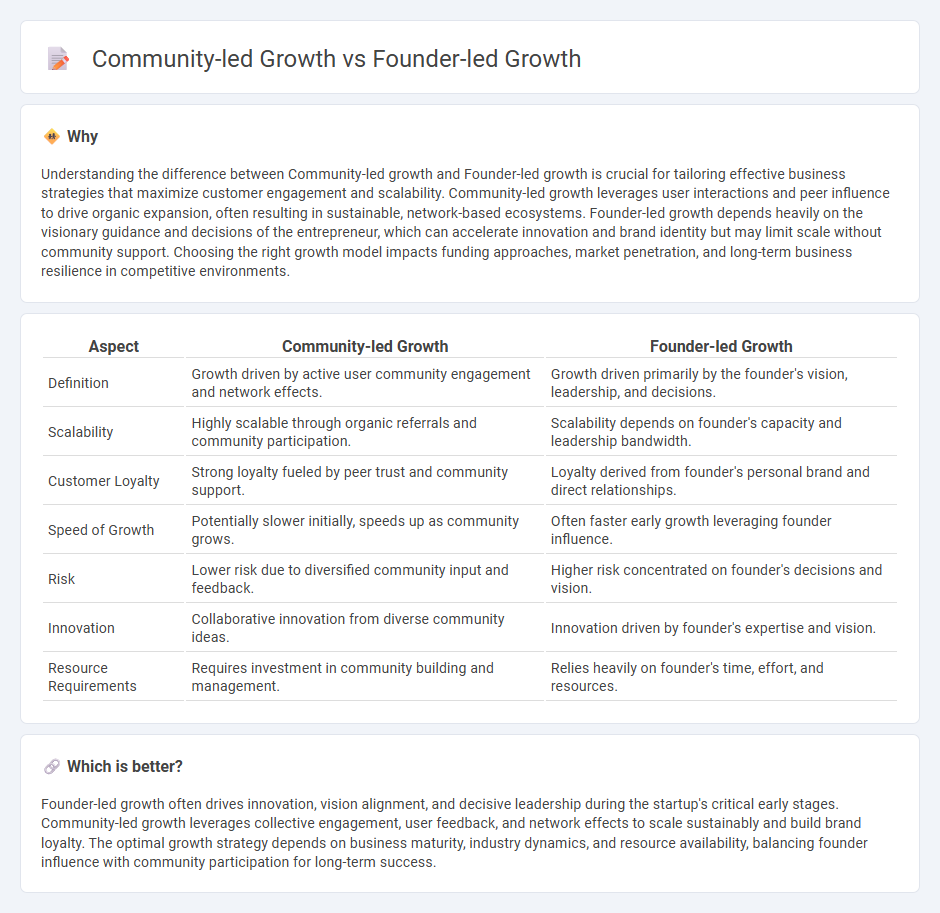
Community-led growth emphasizes leveraging the collective power of engaged users and advocates to drive product adoption, increase brand loyalty, and foster organic expansion, contrasting with founder-led growth strategies that rely heavily on the vision, decision-making, and direct involvement of the entrepreneur. Successful community-led companies such as Glossier and Twitch demonstrate scalable network effects and customer-driven innovation, while founder-led models like Amazon showcase centralized control fostering rapid product iteration and strategic pivots. Explore the unique advantages and challenges of each approach to optimize growth trajectories in entrepreneurial ventures.
Why it is important
Understanding the difference between Community-led growth and Founder-led growth is crucial for tailoring effective business strategies that maximize customer engagement and scalability. Community-led growth leverages user interactions and peer influence to drive organic expansion, often resulting in sustainable, network-based ecosystems. Founder-led growth depends heavily on the visionary guidance and decisions of the entrepreneur, which can accelerate innovation and brand identity but may limit scale without community support. Choosing the right growth model impacts funding approaches, market penetration, and long-term business resilience in competitive environments.
Comparison Table
| Aspect | Community-led Growth | Founder-led Growth |
|---|---|---|
| Definition | Growth driven by active user community engagement and network effects. | Growth driven primarily by the founder's vision, leadership, and decisions. |
| Scalability | Highly scalable through organic referrals and community participation. | Scalability depends on founder's capacity and leadership bandwidth. |
| Customer Loyalty | Strong loyalty fueled by peer trust and community support. | Loyalty derived from founder's personal brand and direct relationships. |
| Speed of Growth | Potentially slower initially, speeds up as community grows. | Often faster early growth leveraging founder influence. |
| Risk | Lower risk due to diversified community input and feedback. | Higher risk concentrated on founder's decisions and vision. |
| Innovation | Collaborative innovation from diverse community ideas. | Innovation driven by founder's expertise and vision. |
| Resource Requirements | Requires investment in community building and management. | Relies heavily on founder's time, effort, and resources. |
Which is better?
Founder-led growth often drives innovation, vision alignment, and decisive leadership during the startup's critical early stages. Community-led growth leverages collective engagement, user feedback, and network effects to scale sustainably and build brand loyalty. The optimal growth strategy depends on business maturity, industry dynamics, and resource availability, balancing founder influence with community participation for long-term success.
Connection
Community-led growth leverages the collective engagement of users to drive product adoption and brand loyalty, creating a scalable network effect essential for startup success. Founder-led growth involves the founder's direct involvement in customer interactions, establishing trust and personalized experiences that foster early traction. These strategies connect as founder insights shape community dynamics, while active communities amplify the founder's vision, accelerating sustainable entrepreneurial growth.
Key Terms
Vision Alignment
Founder-led growth emphasizes the founder's vision as the primary driver for company strategy and decision-making, ensuring cohesive direction and strong leadership commitment. Community-led growth prioritizes building a loyal user base that aligns with brand values and co-creates value through engagement and feedback. Explore how aligning vision in both approaches can amplify sustainable growth strategies.
Network Effects
Founder-led growth relies on the vision, expertise, and decision-making of the startup's founders to drive innovation and scale, often emphasizing strong leadership and strategic control. Community-led growth leverages network effects by empowering users to engage, share, and contribute value, accelerating organic expansion through active participation and user advocacy. Explore the dynamics of founder influence versus community-driven network effects to optimize your growth strategy.
Scalability
Founder-led growth leverages the vision and direct involvement of the founder to drive early-stage scalability with strong brand identity and decision-making agility. Community-led growth scales by empowering user communities to generate organic adoption and network effects, reducing acquisition costs and improving retention rates at scale. Explore the comparative benefits and scalable strategies of founder-led versus community-led growth models to optimize your business expansion.
Source and External Links
What is Founder-Led Growth? Understanding the Founder-Led Growth Motion for Startups - Ascend Labs - Founder-Led Growth is a business strategy that leverages the company founder's deep industry knowledge, passion, and personal brand in driving growth through direct customer engagement and strategic marketing, especially effective for startups seeking to build trust and differentiate themselves early on.
Founder-Led Growth Playbook - First Round Review - This playbook emphasizes that startup founders should personally own growth efforts early on, as the insights gained from discovering growth levers are vital for understanding the business and market, rather than delegating growth to others prematurely.
Shifting from a Founder-Led Business - Chief Outsiders - Transitioning from a founder-led business to scalable growth involves formalizing infrastructure, exporting founder knowledge, and enabling others to execute day-to-day operations while maintaining the founder's strategic influence for long-term success.
 dowidth.com
dowidth.com